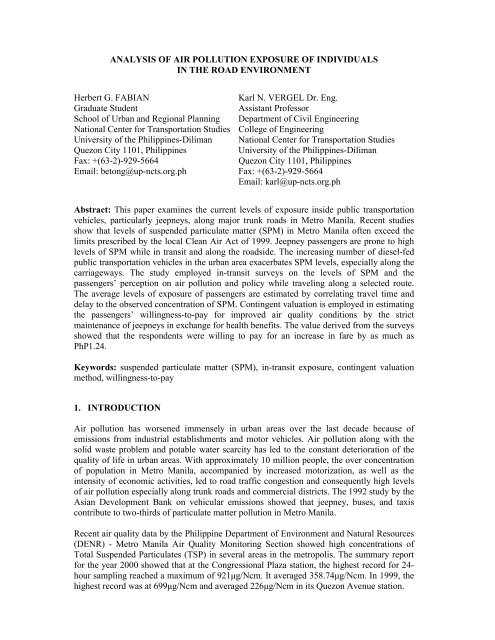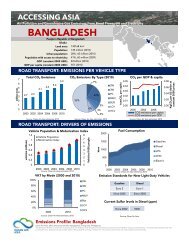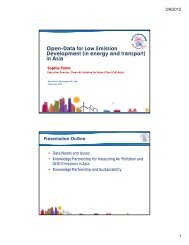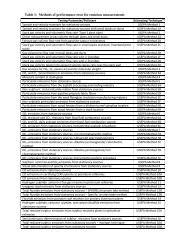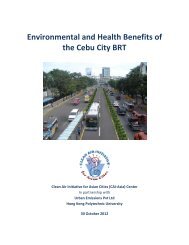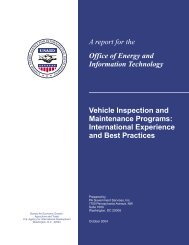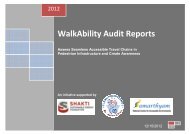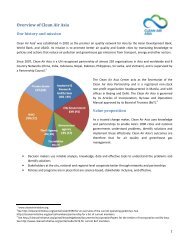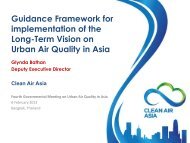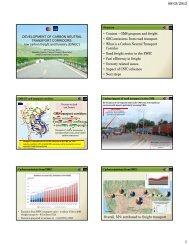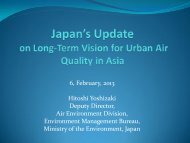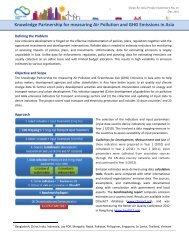Analysis of Air Pollution Exposure of Individuals in - Clean Air Initiative
Analysis of Air Pollution Exposure of Individuals in - Clean Air Initiative
Analysis of Air Pollution Exposure of Individuals in - Clean Air Initiative
Create successful ePaper yourself
Turn your PDF publications into a flip-book with our unique Google optimized e-Paper software.
ANALYSIS OF AIR POLLUTION EXPOSURE OF INDIVIDUALS<br />
IN THE ROAD ENVIRONMENT<br />
Herbert G. FABIAN Karl N. VERGEL Dr. Eng.<br />
Graduate Student Assistant Pr<strong>of</strong>essor<br />
School <strong>of</strong> Urban and Regional Plann<strong>in</strong>g Department <strong>of</strong> Civil Eng<strong>in</strong>eer<strong>in</strong>g<br />
National Center for Transportation Studies College <strong>of</strong> Eng<strong>in</strong>eer<strong>in</strong>g<br />
University <strong>of</strong> the Philipp<strong>in</strong>es-Diliman National Center for Transportation Studies<br />
Quezon City 1101, Philipp<strong>in</strong>es University <strong>of</strong> the Philipp<strong>in</strong>es-Diliman<br />
Fax: +(63-2)-929-5664 Quezon City 1101, Philipp<strong>in</strong>es<br />
Email: betong@up-ncts.org.ph Fax: +(63-2)-929-5664<br />
Email: karl@up-ncts.org.ph<br />
Abstract: This paper exam<strong>in</strong>es the current levels <strong>of</strong> exposure <strong>in</strong>side public transportation<br />
vehicles, particularly jeepneys, along major trunk roads <strong>in</strong> Metro Manila. Recent studies<br />
show that levels <strong>of</strong> suspended particulate matter (SPM) <strong>in</strong> Metro Manila <strong>of</strong>ten exceed the<br />
limits prescribed by the local <strong>Clean</strong> <strong>Air</strong> Act <strong>of</strong> 1999. Jeepney passengers are prone to high<br />
levels <strong>of</strong> SPM while <strong>in</strong> transit and along the roadside. The <strong>in</strong>creas<strong>in</strong>g number <strong>of</strong> diesel-fed<br />
public transportation vehicles <strong>in</strong> the urban area exacerbates SPM levels, especially along the<br />
carriageways. The study employed <strong>in</strong>-transit surveys on the levels <strong>of</strong> SPM and the<br />
passengers’ perception on air pollution and policy while travel<strong>in</strong>g along a selected route.<br />
The average levels <strong>of</strong> exposure <strong>of</strong> passengers are estimated by correlat<strong>in</strong>g travel time and<br />
delay to the observed concentration <strong>of</strong> SPM. Cont<strong>in</strong>gent valuation is employed <strong>in</strong> estimat<strong>in</strong>g<br />
the passengers’ will<strong>in</strong>gness-to-pay for improved air quality conditions by the strict<br />
ma<strong>in</strong>tenance <strong>of</strong> jeepneys <strong>in</strong> exchange for health benefits. The value derived from the surveys<br />
showed that the respondents were will<strong>in</strong>g to pay for an <strong>in</strong>crease <strong>in</strong> fare by as much as<br />
PhP1.24.<br />
Keywords: suspended particulate matter (SPM), <strong>in</strong>-transit exposure, cont<strong>in</strong>gent valuation<br />
method, will<strong>in</strong>gness-to-pay<br />
1. INTRODUCTION<br />
<strong>Air</strong> pollution has worsened immensely <strong>in</strong> urban areas over the last decade because <strong>of</strong><br />
emissions from <strong>in</strong>dustrial establishments and motor vehicles. <strong>Air</strong> pollution along with the<br />
solid waste problem and potable water scarcity has led to the constant deterioration <strong>of</strong> the<br />
quality <strong>of</strong> life <strong>in</strong> urban areas. With approximately 10 million people, the over concentration<br />
<strong>of</strong> population <strong>in</strong> Metro Manila, accompanied by <strong>in</strong>creased motorization, as well as the<br />
<strong>in</strong>tensity <strong>of</strong> economic activities, led to road traffic congestion and consequently high levels<br />
<strong>of</strong> air pollution especially along trunk roads and commercial districts. The 1992 study by the<br />
Asian Development Bank on vehicular emissions showed that jeepney, buses, and taxis<br />
contribute to two-thirds <strong>of</strong> particulate matter pollution <strong>in</strong> Metro Manila.<br />
Recent air quality data by the Philipp<strong>in</strong>e Department <strong>of</strong> Environment and Natural Resources<br />
(DENR) - Metro Manila <strong>Air</strong> Quality Monitor<strong>in</strong>g Section showed high concentrations <strong>of</strong><br />
Total Suspended Particulates (TSP) <strong>in</strong> several areas <strong>in</strong> the metropolis. The summary report<br />
for the year 2000 showed that at the Congressional Plaza station, the highest record for 24hour<br />
sampl<strong>in</strong>g reached a maximum <strong>of</strong> 921µg/Ncm. It averaged 358.74µg/Ncm. In 1999, the<br />
highest record was at 699µg/Ncm and averaged 226µg/Ncm <strong>in</strong> its Quezon Avenue station.
Human exposure to motor vehicle emissions is greater <strong>in</strong> urban areas as compared to rural<br />
areas, primarily because cities have more roadways, park<strong>in</strong>g garages, and street canyons<br />
where people may be exposed to high pollutant concentrations due to motor vehicle<br />
emissions (Schwela and Zali, 1999). Variations <strong>in</strong> pollutant concentration are observed <strong>in</strong><br />
different microenvironments (<strong>in</strong>side build<strong>in</strong>gs, <strong>in</strong>side homes, <strong>in</strong>side vehicles, along<br />
roadways, etc.) <strong>in</strong> the urban area. <strong>Individuals</strong> <strong>in</strong> the roadside environment and <strong>in</strong>-transit are<br />
both exposed to pollutants; they vary with the amount <strong>of</strong> concentration and the length <strong>of</strong><br />
exposure. Several studies have already confirmed the health effects <strong>of</strong> air pollutants on the<br />
exposed public. Observed effects may be an aggravation <strong>of</strong> exist<strong>in</strong>g respiratory diseases,<br />
disruption <strong>of</strong> physiological processes or physical <strong>in</strong>conveniences to the affected population.<br />
The number <strong>of</strong> people exposed to air pollutants from motor vehicles depends upon the extent<br />
to which a country is motorized (Schwela and Zali 1999). The number <strong>of</strong> registered motor<br />
vehicles <strong>in</strong> Metro Manila as shown by the Land Transportation Office statistics is at an<br />
<strong>in</strong>creas<strong>in</strong>g trend with a very high rate, the number <strong>of</strong> registered vehicles by fuel type shows<br />
that diesel-run vehicles have <strong>in</strong>creased by 613% and gas-run vehicles by 115% from 1980 to<br />
1999.<br />
There have been few studies <strong>in</strong>vestigat<strong>in</strong>g <strong>in</strong>-transit levels <strong>of</strong> SPM and other pollutants. The<br />
California <strong>Air</strong> Resources Board has posted a summary <strong>of</strong> the study “Measur<strong>in</strong>g<br />
Concentrations <strong>of</strong> Selected <strong>Air</strong> Pollutants <strong>in</strong>side California Vehicles”. This study was<br />
conducted to characterize the concentration levels <strong>of</strong> selected pollutants <strong>in</strong>side commut<strong>in</strong>g <strong>in</strong><br />
the Sacramento and Los Angeles areas <strong>in</strong> California. The results showed relatively higher<br />
levels <strong>of</strong> all pollutants measured as compared to ambient concentrations as taken from the<br />
mean <strong>of</strong> commutes <strong>in</strong> Sacramento and Los Angeles.<br />
The health <strong>of</strong> passengers and pedestrians can be adversely affected as a result <strong>of</strong> their<br />
constant exposure to high levels <strong>of</strong> air pollutants. Majority <strong>of</strong> the population <strong>in</strong> Metro<br />
Manila rely heavily on public transportation and spends a considerable amount <strong>of</strong> time<br />
travel<strong>in</strong>g along congested roadways. The purpose <strong>of</strong> this study is to evaluate the levels <strong>of</strong><br />
exposure to SPM <strong>of</strong> commuters <strong>in</strong> major trunk roads <strong>in</strong> Metro Manila. The study also aims<br />
to <strong>in</strong>vestigate the factors <strong>in</strong>fluenc<strong>in</strong>g <strong>in</strong>-transit levels <strong>of</strong> SPM. Specifically, the research aims<br />
to:<br />
• measure the amount <strong>of</strong> typical SPM concentration <strong>in</strong>side public vehicles dur<strong>in</strong>g peak<br />
hours along key trunk roads <strong>in</strong> Metro Manila<br />
• estimate the length <strong>of</strong> time a commuter is exposed to vary<strong>in</strong>g concentration <strong>of</strong> SPM<br />
• compare <strong>in</strong>-transit concentration to ambient concentration <strong>of</strong> SPM<br />
• <strong>in</strong>vestigate the feasibility <strong>of</strong> a policy aim<strong>in</strong>g to reduce vehicle-generated emissions<br />
Figure 1 shows the relationship <strong>of</strong> factors affect<strong>in</strong>g air pollution <strong>in</strong> the transportation<br />
environment. This study is focused on air pollution, particularly SPM, from motor vehicles.<br />
The jeepney is selected as the representative public transportation mode, s<strong>in</strong>ce accord<strong>in</strong>g to<br />
the Metro Manila Urban Transportation Integration Study (MMUTIS, 1996), 62% <strong>of</strong> the<br />
respondents use the jeepney to reach their dest<strong>in</strong>ation, mak<strong>in</strong>g the jeepney a major mode <strong>of</strong><br />
public transportation <strong>in</strong> the urban area. The jeepney is a paratransit vehicle sitt<strong>in</strong>g 18-20<br />
passengers, with a second-hand truck diesel eng<strong>in</strong>e.<br />
<strong>Air</strong> pollutants from motor vehicles are greatly dependent on meteorological conditions such<br />
as w<strong>in</strong>d velocity, temperature, and humidity and also the way these pollutants <strong>in</strong>teract with<br />
the elements. This study focuses on <strong>in</strong>-transit levels <strong>of</strong> SPM concentration. The behavior <strong>of</strong>
these pollutants <strong>in</strong>side vehicles is dependent on the vehicles’ ventilation characteristics as<br />
affected by the ambient concentration but does not follow the dispersion <strong>of</strong> ambient air<br />
pollutants. The health effects <strong>of</strong> air pollution on passengers may be deduced from the<br />
<strong>in</strong>vestigation <strong>of</strong> their travel behavior, socio-economic status and the observed levels <strong>of</strong><br />
exposure.<br />
Industries Motor Vehicles<br />
Other sources<br />
Figure 1. Conceptual Framework <strong>of</strong> the Study<br />
The succeed<strong>in</strong>g parts <strong>of</strong> this paper <strong>in</strong>clude the analysis <strong>of</strong> jeepney passengers’ daily<br />
exposure to suspended particulate matter, followed by the multivariate analysis <strong>of</strong> the<br />
passengers’ will<strong>in</strong>gness-to-pay for air quality improvement. Furthermore, the proposed<br />
strategy to improve air quality <strong>in</strong> the road environment would be discussed as per the results<br />
<strong>of</strong> the will<strong>in</strong>gness-to-pay analysis.<br />
2. ANALYSIS OF INDIVIDUAL EXPOSURE TO SPM<br />
2.1 Route Selection<br />
<strong>Air</strong><br />
<strong>Pollution</strong><br />
Dispersion<br />
In-transit Roadside<br />
Concentration<br />
<strong>Exposure</strong> length<br />
Health Effects<br />
Traffic Flow<br />
Meteorological Forces<br />
Travel Behavior<br />
Community Perception<br />
Based from MMUTIS (MMUTIS, 1996) data, one <strong>of</strong> the route that have a high volume <strong>of</strong><br />
passengers per day was identified as com<strong>in</strong>g from the northern part <strong>of</strong> Quezon City, along<br />
Commonwealth Avenue, Quezon Avenue, España Avenue towards the southwest to Taft<br />
Avenue <strong>in</strong> the heart <strong>of</strong> Manila. The jeepney route selected started from Philcoa bus and<br />
jeepney stop, pass<strong>in</strong>g the stretch <strong>of</strong> Quezon Avenue and España Avenue, over Quezon
Bridge and f<strong>in</strong>ally to Taft Avenue end<strong>in</strong>g <strong>in</strong> T.M. Kalaw Avenue. The route from Philcoa to<br />
T.M. Kalaw Avenue was measured to be 11.61 km, while the return trip measured 11.85 km.<br />
Figure 2. Study Area and Survey Route<br />
The high volume <strong>of</strong> jeepneys along this route was also <strong>in</strong>dicative <strong>of</strong> the high levels <strong>of</strong> SPM<br />
emitted by diesel eng<strong>in</strong>es. The “<strong>Air</strong> <strong>Pollution</strong> Survey Us<strong>in</strong>g Filter Badge <strong>in</strong> Metro Manila”<br />
(1998) obta<strong>in</strong>ed data on traffic volume along Quezon Avenue and España Avenue. The<br />
jeepney traffic volume along Quezon Avenue had an average <strong>of</strong> 153 jeepneys/hr, while<br />
España Avenue had 400 jeepneys/hr for both directions.<br />
Ambient monitor<strong>in</strong>g stations for SPM may not be found <strong>in</strong> all parts <strong>of</strong> the route, however,<br />
the DENR-NCR <strong>Air</strong> Quality Monitor<strong>in</strong>g Section has one station along Quezon Avenue as<br />
released from their summary report for 1999. The summary shows that it had an annual<br />
average <strong>of</strong> 226µg/Ncm for 24-hour sampl<strong>in</strong>g <strong>of</strong> Total Suspended Particles, near<strong>in</strong>g the limit<br />
<strong>of</strong> 230µg/Ncm for 24-hour sampl<strong>in</strong>g.<br />
2.2 SPM Count, Travel Time and Delay Survey<br />
A surveyor was tasked to record the read<strong>in</strong>gs <strong>of</strong> SPM count cumulatively per m<strong>in</strong>ute start<strong>in</strong>g<br />
from the time the jeepney was boarded on Philcoa bus/jeepney stop. The Sibata® Digital<br />
Dust Indicator LD-3 was used as the measur<strong>in</strong>g device. Simultaneously, another surveyor<br />
records travel time and delay start<strong>in</strong>g when the jeepney was boarded. Both measurements<br />
stop when T.M. Kalaw Avenue was reached, this was considered as one run with start<strong>in</strong>g<br />
time <strong>of</strong> approximately 7:00 am. The second run started from T.M. Kalaw Avenue and ended<br />
<strong>in</strong> Philcoa, which is the return trip <strong>of</strong> the jeepney. Another set <strong>of</strong> runs started <strong>in</strong> the<br />
afternoon, approximately start<strong>in</strong>g at 4:00 pm from Philcoa. The dates for the survey runs<br />
were all weekdays, February 8, 9 and 12, 2001 respectively, so as to capture the bulk <strong>of</strong><br />
passenger trips. The actual time <strong>of</strong> observations dur<strong>in</strong>g the morn<strong>in</strong>g and afternoon runs are<br />
presented <strong>in</strong> Table 1.
Table 1. Start and End Time <strong>of</strong> the Runs to and from Philcoa to Kalaw<br />
ug/ Ncm<br />
Philcoa - Kalaw Kalaw - Philcoa<br />
AM PM AM PM<br />
2/8/2001 7:12 - 8:17 4:13 - 5:12 8:29 - 9:14 5:33 - 6:50<br />
2/9/2001 6:51 - 7:53 4:18 - 5:21 7:59 - 8:55 5:27 - 6:34<br />
2/12/2001 7:05 - 8:09 4:03 - 5:20 8:17 - 9:07 5:21 - 6:42<br />
2.3 SPM <strong>Exposure</strong> and Travel Time <strong>Analysis</strong><br />
The level <strong>of</strong> exposure <strong>of</strong> <strong>in</strong>dividuals <strong>in</strong> the road environment is greatly dependent on the<br />
amount <strong>of</strong> time they spend on the road environment, along the roadside and <strong>in</strong>-transit. The<br />
total daily exposure <strong>of</strong> an <strong>in</strong>dividual to air pollution is the sum <strong>of</strong> the separate contacts to air<br />
pollution experienced by the <strong>in</strong>dividual as he pass through a series <strong>of</strong> environments (also<br />
called microenvironments) dur<strong>in</strong>g the course <strong>of</strong> the day (e.g. at home, while commut<strong>in</strong>g, <strong>in</strong><br />
the streets, etc.). <strong>Exposure</strong> <strong>in</strong> each <strong>of</strong> these environments can be estimated as the product <strong>of</strong><br />
the pollutant concentration and the time spent <strong>in</strong> specific microenvironments (WHO, 2000).<br />
This paper uses this concept <strong>in</strong> estimat<strong>in</strong>g the total exposure <strong>of</strong> the affected population us<strong>in</strong>g<br />
public transportation. The general form <strong>of</strong> the equation used to calculate time-weighted<br />
<strong>in</strong>tegrated exposure is:<br />
J<br />
Εί = Σ Cj tij (1)<br />
j<br />
where Εί is the time-weighted <strong>in</strong>tegrated exposure for person i over the specified time<br />
period; Cj is the pollutant concentration <strong>in</strong> micro-environment j; and J is the total number <strong>of</strong><br />
microenvironments that person i moves through the specified time period (Sexton and Ryan,<br />
1988). A microenvironment is def<strong>in</strong>ed as a three-dimensional space where the pollutant<br />
level at some specified time is uniform or has constant statistical properties. Outdoors <strong>in</strong> a<br />
specific community, <strong>in</strong>side a motor vehicle, and <strong>in</strong>side a particular residence are examples<br />
<strong>of</strong> locations that can be def<strong>in</strong>ed, under appropriate conditions, microenvironments (Sexton<br />
and Ryan, 1988).<br />
The results <strong>of</strong> the observed values <strong>of</strong> SPM concentrations are presented <strong>in</strong> the follow<strong>in</strong>g<br />
figures. The graphical representations <strong>of</strong> the runs show similarities with the trends <strong>of</strong> SPM<br />
concentrations by time. Figures 3 and 4 show the observed SPM concentrations <strong>in</strong>side the<br />
jeepney from Philcoa to T.M. Kalaw. Figures 5 and 6 show the observed SPM<br />
concentrations <strong>in</strong>side the jeepney from T.M. Kalaw to Philcoa. The concentrations are<br />
presented with respect to the travel time per m<strong>in</strong>ute.<br />
2500<br />
2000<br />
1500<br />
1000<br />
500<br />
0<br />
0<br />
4<br />
8<br />
12<br />
16<br />
20<br />
24<br />
28<br />
32<br />
36<br />
40<br />
44<br />
travel time <strong>in</strong> m <strong>in</strong>utes<br />
48<br />
52<br />
56<br />
60<br />
64<br />
8-Feb<br />
9-Feb<br />
12-Feb<br />
Figure 3. Observed SPM Concentration from Philcoa to T.M. Kalaw Avenue<br />
dur<strong>in</strong>g the Morn<strong>in</strong>g Peak Runs
ug/ Ncm<br />
ug/ Ncm<br />
900<br />
800<br />
700<br />
600<br />
500<br />
400<br />
300<br />
200<br />
100<br />
0<br />
0<br />
1800<br />
1600<br />
1400<br />
1200<br />
1000<br />
800<br />
600<br />
400<br />
200<br />
0<br />
0<br />
4<br />
3<br />
6<br />
travel time <strong>in</strong> m<strong>in</strong>utes<br />
travel time <strong>in</strong> m<strong>in</strong>utes<br />
8<br />
12<br />
16<br />
20<br />
24<br />
28<br />
32<br />
36<br />
40<br />
44<br />
48<br />
52<br />
56<br />
60<br />
64<br />
68<br />
72<br />
76<br />
9<br />
12<br />
15<br />
18<br />
21<br />
24<br />
27<br />
30<br />
33<br />
36<br />
39<br />
42<br />
45<br />
48<br />
51<br />
54<br />
8-Feb<br />
9-Feb<br />
12-Feb<br />
Figure 4. Observed SPM Concentration from Philcoa to T.M. Kalaw Avenue<br />
dur<strong>in</strong>g the Afternoon Peak Runs<br />
ug/ Ncm<br />
1200<br />
1000<br />
800<br />
600<br />
400<br />
200<br />
0<br />
0<br />
5<br />
10<br />
15<br />
20<br />
25<br />
30<br />
35<br />
40<br />
45<br />
50<br />
55<br />
60<br />
travel time <strong>in</strong> m<strong>in</strong>utes<br />
65<br />
70<br />
75<br />
80<br />
8-Feb<br />
9-Feb<br />
12-Feb<br />
Figure 5. Observed SPM Concentration from T.M. Kalaw Avenue to Philcoa<br />
dur<strong>in</strong>g the Morn<strong>in</strong>g Peak Runs<br />
8-Feb<br />
9-Feb<br />
12-Feb<br />
Figure 6. Observed SPM Concentration from T.M. Kalaw Avenue to Philcoa<br />
dur<strong>in</strong>g the Afternoon Peak Runs<br />
The average travel time was computed from the morn<strong>in</strong>g and afternoon runs to and from<br />
Philcoa to T.M. Kalaw Avenue. The variations <strong>of</strong> travel speed from Philcoa to T.M. Kalaw<br />
Avenue <strong>in</strong> the morn<strong>in</strong>g and <strong>in</strong> the afternoon can be seen <strong>in</strong> Figures 7 and 8 show<strong>in</strong>g the<br />
mean travel speed and mean runn<strong>in</strong>g speed <strong>of</strong> the runs <strong>in</strong> the morn<strong>in</strong>g and <strong>in</strong> the afternoon<br />
with respect to the distance covered.<br />
The average travel time was computed from all the runs separately per direction and time <strong>of</strong><br />
day. Summary <strong>of</strong> the average travel time is presented <strong>in</strong> Table 2. It was observed that runs<br />
dur<strong>in</strong>g the afternoon took a relatively longer time than the morn<strong>in</strong>g runs. All runs were done<br />
dur<strong>in</strong>g peak hours but it is evident that travel time was longer dur<strong>in</strong>g the afternoon peak<br />
hours.
Speed (kph)<br />
Speed (kph)<br />
35<br />
30<br />
25<br />
20<br />
15<br />
10<br />
5<br />
0<br />
35<br />
30<br />
25<br />
20<br />
15<br />
10<br />
5<br />
0<br />
AM Philcoa - Kalaw Runs<br />
0 2 4 6 8 10 12 14<br />
Distance Covered (km)<br />
travel speed mean travel speed mean runn<strong>in</strong>g speed<br />
AM Kalaw to Philcoa Runs<br />
0 2 4 6 8 10 12 14<br />
Distance Covered (km)<br />
travel speed mean travel speed mean runn<strong>in</strong>g speed<br />
PM Philcoa - Kalaw Runs<br />
Philcoa - Kalaw Kalaw - Philcoa<br />
AM PM AM PM<br />
2/8/2001 65 59 45 77<br />
2/9/2001 62 63 56 67<br />
2/12/2001 64 77 50 81<br />
Average 64 66 50 75<br />
Speed (kph)<br />
35<br />
30<br />
25<br />
20<br />
15<br />
10<br />
5<br />
0<br />
0 2 4 6 8 10 12 14<br />
Distance Covered (km)<br />
travel speed mean travel speed mean runn<strong>in</strong>g speed<br />
Figure 7. Travel Speed-Distance Diagram for AM and PM Runs from<br />
Philcoa to T.M. Kalaw Avenue<br />
Speed (kph)<br />
30<br />
25<br />
20<br />
15<br />
10<br />
5<br />
0<br />
PM Kalaw - Philcoa Runs<br />
0 2 4 6 8 10 12 14<br />
Distance Covered (km)<br />
travel speed mean travel speed mean runn<strong>in</strong>g speed<br />
Figure 8. Travel Speed-Distance Diagram for AM and PM Runs from<br />
T.M. Kalaw Avenue to Philcoa<br />
Table 2. Summary <strong>of</strong> Travel Time to and from Philcoa to T.M. Kalaw Avenue <strong>in</strong> M<strong>in</strong>utes<br />
The authors used different sections along the route with the observed delays to compute the<br />
average travel speed and runn<strong>in</strong>g speed for each section. The sections identified were mostly<br />
between signalized <strong>in</strong>tersections along the route.<br />
Figures 9 to 12 show the variation <strong>in</strong> the measured SPM concentration with respect to the<br />
different sections along the route. There is high variation <strong>in</strong> the observed section<br />
concentrations. A probable reason is that the different sections chosen along the route are<br />
not equidistant from each other, however, as shown <strong>in</strong> the graphs, there are still sections that<br />
have very high disparities among the observed levels for the different runs. This signifies<br />
that the distances between the specified sections do not directly affect SPM concentrations.<br />
The sensitivity <strong>of</strong> the measur<strong>in</strong>g <strong>in</strong>strument to SPM from direct emissions <strong>of</strong> jeepneys along<br />
the route is the reason for these erratic concentrations <strong>of</strong> SPM <strong>in</strong>side the jeepney while <strong>in</strong><br />
transit. Smoke-belch<strong>in</strong>g vehicles near the ridden jeepney or the smoke emitted by the ridden<br />
jeepney itself <strong>in</strong>creases the read<strong>in</strong>gs taken from the measur<strong>in</strong>g <strong>in</strong>strument. Nonetheless, the
observed concentrations <strong>of</strong> SPM are very high compared to ambient concentrations.<br />
Ambient concentrations are measured on a short-term and long-term basis with short-term<br />
monitor<strong>in</strong>g equal to a 24-hour sampl<strong>in</strong>g period and long-term monitor<strong>in</strong>g equal to an annual<br />
sampl<strong>in</strong>g period. The observed concentrations <strong>of</strong> SPM <strong>in</strong>side the jeepney and while <strong>in</strong><br />
transit, only stands for the amount <strong>of</strong> time an <strong>in</strong>dividual is <strong>in</strong> transit.<br />
ug/Ncm<br />
ug/Ncm<br />
2000<br />
1800<br />
1600<br />
1400<br />
1200<br />
1000<br />
800<br />
600<br />
400<br />
200<br />
0<br />
700<br />
600<br />
500<br />
400<br />
300<br />
200<br />
100<br />
0<br />
1 3 5 7 9 11 13 15 17 19 21 23 25 27 29<br />
sections<br />
1 3 5 7 9 11 13 15 17 19 21 23 25 27 29<br />
sections<br />
8-Feb<br />
9-Feb<br />
12-Feb<br />
Figure 9. Average SPM Concentration by Section from Philcoa to T.M. Kalaw Avenue<br />
dur<strong>in</strong>g the Morn<strong>in</strong>g Peak Runs<br />
ug/Ncm<br />
1400<br />
1200<br />
1000<br />
800<br />
600<br />
400<br />
200<br />
0<br />
1 3 5 7 9 11 13 15 17 19 21 23 25 27 29<br />
sections<br />
8-Feb<br />
9-Feb<br />
12-Feb<br />
Figure 10. Average SPM Concentration by Section from Philcoa to T.M. Kalaw Avenue<br />
dur<strong>in</strong>g the Afternoon Peak Runs<br />
8-Feb<br />
9-Feb<br />
12-Feb<br />
Figure 11. Average SPM Concentration by Section from T.M. Kalaw Avenue to Philcoa<br />
dur<strong>in</strong>g the Morn<strong>in</strong>g Peak Runs
ug/Ncm<br />
1000<br />
900<br />
800<br />
700<br />
600<br />
500<br />
400<br />
300<br />
200<br />
100<br />
0<br />
1 3 5 7 9 11 13 15 17 19 21 23 25 27 29<br />
sections<br />
Philcoa - Kalaw Kalaw - Philcoa<br />
AM PM AM PM<br />
8-Feb 55.94 7.72 19.47 13.01<br />
9-Feb 18.08 12.14 14.24 14.16<br />
12-Feb 26.53 10.59 18.07 18.81<br />
Average 33.52 10.15 17.26 15.33<br />
8-Feb<br />
9-Feb<br />
12-Feb<br />
Figure 12. Average SPM Concentration by Section from T.M. Kalaw Avenue to Philcoa<br />
dur<strong>in</strong>g the Afternoon Peak Runs<br />
The travel time data and the observed values <strong>of</strong> SPM concentrations while <strong>in</strong> transit were<br />
used <strong>in</strong> estimat<strong>in</strong>g the levels <strong>of</strong> exposure <strong>of</strong> <strong>in</strong>dividuals while <strong>in</strong> transit. The 24-hour timefraction<br />
<strong>of</strong> the time spent <strong>in</strong> each section throughout the route was used to get the levels <strong>of</strong><br />
exposure <strong>of</strong> <strong>in</strong>dividuals while <strong>in</strong>side the jeepney and <strong>in</strong> transit.<br />
Us<strong>in</strong>g equation (1), the levels <strong>of</strong> exposure <strong>of</strong> <strong>in</strong>dividuals <strong>in</strong>side jeepneys were computed.<br />
The average values are shown <strong>in</strong> Table 4.<br />
Table 3. Estimated Levels <strong>of</strong> <strong>Exposure</strong> <strong>of</strong> Passengers <strong>in</strong>side Jeepneys (µg/Ncm)<br />
Studies regard<strong>in</strong>g time-activity patterns <strong>of</strong> <strong>in</strong>dividuals help <strong>in</strong> the over-all estimation <strong>of</strong> an<br />
<strong>in</strong>tegrated exposure assessment to air pollution for a 24-hour period. In a study by Szalai<br />
(1992) and Chap<strong>in</strong> (1974), they presented a 24-hour activity pattern for an <strong>in</strong>dividual. Both<br />
studies found that on most days people are <strong>in</strong>side their residences for an average <strong>of</strong> 65 to 70<br />
percent <strong>of</strong> the time, and <strong>in</strong>doors at home, work, or elsewhere for more than 90 percent <strong>of</strong> the<br />
time. Although these values vary with age, gender, occupation, socio-economic status, and<br />
day <strong>of</strong> the week, it has become clear that <strong>in</strong>door microenvironments must be taken <strong>in</strong>to<br />
account for a realistic assessment <strong>of</strong> exposure to many air pollutants (Sexton and Ryan,<br />
1988). Correspond<strong>in</strong>gly, the concentration <strong>of</strong> respirable suspended particles was used to<br />
compute exposure levels. The study emphasized the importance <strong>of</strong> evaluat<strong>in</strong>g <strong>in</strong>-transit<br />
exposure s<strong>in</strong>ce the results show that <strong>in</strong>-transit exposure contributes to 15% <strong>of</strong> the exposure<br />
for a 24-hour <strong>in</strong>tegrated period. Also, <strong>in</strong>-transit levels <strong>of</strong> respirable suspended particle<br />
concentrations were observed to be higher than other microenvironments. Respirable<br />
suspended particles, also synonymous with suspended particulate matter are those particles<br />
that can be <strong>in</strong>haled by humans.<br />
The level <strong>of</strong> exposure <strong>of</strong> the <strong>in</strong>dividual on each section <strong>of</strong> the trip was computed from the<br />
observed concentration <strong>of</strong> SPM and the time spent as shown <strong>in</strong> Figure 13. This was done <strong>in</strong><br />
order to <strong>in</strong>vestigate the amount <strong>of</strong> exposure an <strong>in</strong>dividual takes along the trip.
ug/Ncm<br />
4.5<br />
4<br />
3.5<br />
3<br />
2.5<br />
2<br />
1.5<br />
1<br />
0.5<br />
0<br />
0 5 10 15 20 25 30 35<br />
sections<br />
Parameter Intercept SECTTIME<br />
Estimates 0.18613491 0.003528114<br />
St. Error 0.04709825 0.000287613<br />
t-statistic 3.95205562 12.2668888<br />
p-level 9.3653E-05 4.81378E-29<br />
8-Feb<br />
9-Feb<br />
12-Feb<br />
Figure 13. Levels <strong>of</strong> <strong>Exposure</strong> by Section along the Philcoa to Kalaw Route (AM Runs)<br />
The results <strong>of</strong> the surveys show that the average travel time to and from Philcoa to T.M.<br />
Kalaw Avenue is approximately 1 hour. For the number <strong>of</strong> people who frequently use the<br />
Philcoa to T.M. Kalaw Avenue route, the time fraction they spend <strong>in</strong> transit is equal to 0.08<br />
or 2 hours. The observed SPM concentrations and the time spent showed that average levels<br />
<strong>of</strong> exposure for one trip reached a maximum <strong>of</strong> 33.52µg/Ncm and a low <strong>of</strong> 10.15µg/Ncm<br />
(Table 3). This value is only representative <strong>of</strong> the <strong>in</strong>dividual’s exposure to SPM while <strong>in</strong>transit.<br />
The daily limit set by the local <strong>Clean</strong> <strong>Air</strong> Act <strong>of</strong> 1999 is pegged at 230µg/Ncm for shortterm<br />
monitor<strong>in</strong>g <strong>of</strong> suspended particulate matter. Consider<strong>in</strong>g the results <strong>of</strong> the observed<br />
values <strong>of</strong> SPM concentrations while <strong>in</strong> transit, the possible levels <strong>of</strong> exposure yield a high<br />
amount. The average travel time for the Philcoa to T.M. Kalaw Avenue route was observed<br />
to be 2 hours for a round trip and the average level <strong>of</strong> SPM, regardless <strong>of</strong> time and direction<br />
is 19.07µg/Ncm. The exposure level is equal to 17.48µg/Ncm. This is just equivalent to the 2<br />
hours the <strong>in</strong>dividual has spent while travel<strong>in</strong>g.<br />
The relationship <strong>of</strong> SPM and exposure with regard to the travel time and delay study were<br />
analyzed by regress<strong>in</strong>g the SPM concentration and the computed exposure <strong>of</strong> the <strong>in</strong>dividual<br />
while <strong>in</strong> transit on variables such as runn<strong>in</strong>g speed, runn<strong>in</strong>g time, travel speed, and travel<br />
time. The regression result showed a better model by us<strong>in</strong>g the exposure data as the<br />
dependent variable as compared to us<strong>in</strong>g the observed SPM concentrations.<br />
The variable with the most relevant relationship was found to be the travel time for each<br />
section <strong>in</strong>dicated by SECTTIME. Other variables such as runn<strong>in</strong>g speed, distance, travel<br />
speed, and delay showed very little significance <strong>in</strong> the regression. Results <strong>of</strong> the regression<br />
are shown below:<br />
Table 4. Regression Results for <strong>Exposure</strong> and Travel Time<br />
Despite the low R 2 <strong>of</strong> 0.30, this model yielded the highest measure <strong>of</strong> significance as<br />
compared with and <strong>in</strong> comb<strong>in</strong>ation to the other variables such as, runn<strong>in</strong>g speed, runn<strong>in</strong>g<br />
time, delay and travel speed. The positive sign <strong>of</strong> the SECTTIME variable <strong>in</strong>dicates that as<br />
the travel time for a section <strong>in</strong>creases, the exposure <strong>of</strong> the <strong>in</strong>dividual also <strong>in</strong>creases. The
elevance <strong>of</strong> this regression analysis is that the authors were able to look <strong>in</strong>to the possible<br />
factors <strong>in</strong>fluenc<strong>in</strong>g SPM concentration while <strong>in</strong> transit. The regression result was able to<br />
conclude that the concentration <strong>of</strong> SPM is not affected by the runn<strong>in</strong>g speed and delay <strong>of</strong> the<br />
jeepney.<br />
3. WILLINGNESS-TO-PAY FOR THE IMPROVEMENT OF AIR QUALITY<br />
Establish<strong>in</strong>g the fact that passengers are exposed to higher levels <strong>of</strong> SPM as previously<br />
conceived by ambient monitor<strong>in</strong>g, the authors employed a face-to-face <strong>in</strong>terview on the<br />
jeepney passengers <strong>in</strong> transit and while wait<strong>in</strong>g for a ride <strong>in</strong> order to know their perception<br />
and will<strong>in</strong>gness-to-pay for improved air quality.<br />
3.1 Data Collection<br />
Simultaneous with the SPM and travel time and delay survey, another surveyor was tasked<br />
to conduct a face-to-face <strong>in</strong>terview survey <strong>of</strong> passengers <strong>in</strong>side the jeepney while travel<strong>in</strong>g<br />
the route. The passenger’s travel behavior, socio-economic status, perception on health<br />
effects <strong>of</strong> SPM, perception on air quality <strong>in</strong>side jeepneys and on the roadside environment,<br />
and will<strong>in</strong>gness-to-pay was gathered. Another face-to-face <strong>in</strong>terview survey on jeepney<br />
passengers was done on June 13, 2001 at the Philcoa bus/jeepney stop. This time the target<br />
respondents were the people wait<strong>in</strong>g for a jeepney ride.<br />
3.2 Cont<strong>in</strong>gent Valuation Questionnaire<br />
The discrete-response cont<strong>in</strong>gent valuation question <strong>in</strong>troduces the relationship <strong>of</strong> motor<br />
vehicle emissions to human health, particularly suspended particulate matter. The<br />
<strong>in</strong>terviewer clearly expla<strong>in</strong>ed to the respondent that SPM emissions by jeepneys and other<br />
diesel-fed eng<strong>in</strong>es could affect their health. A strategy by the government by mandat<strong>in</strong>g<br />
jeepney drivers/operators to regularly comply with a monthly check-up <strong>of</strong> their vehicles with<br />
the proper authorities was also <strong>in</strong>troduced to the respondent. Then the <strong>in</strong>terviewer expla<strong>in</strong>s<br />
that the drivers/operators may not be able to comply with this policy due to their f<strong>in</strong>ancial<br />
<strong>in</strong>adequacy.<br />
The <strong>in</strong>terviewer then asked the question on their will<strong>in</strong>gness-to-pay for an additional<br />
<strong>in</strong>crease <strong>in</strong> fare. For the first survey, the <strong>in</strong>itial bid was fixed at PhP1.00. If the reply was<br />
‘yes’ then <strong>in</strong>terviewer follows it up with PhP2.00 bid and if the reply was ‘no’, the<br />
<strong>in</strong>terviewer <strong>of</strong>fers a lower cost, PhP0.50. The second survey employed the draw card<br />
technique <strong>in</strong> order to elim<strong>in</strong>ate the <strong>in</strong>itial bid bias. The first bid was randomly chosen by the<br />
respondent from a set <strong>of</strong> cards, after which, their reply was elicited. A higher bid was aga<strong>in</strong><br />
<strong>of</strong>fered by the <strong>in</strong>terviewer, if the reply is ‘yes’ and a lower bid, if otherwise. The second bid<br />
was still drawn from the prepared set <strong>of</strong> cards.<br />
3.3 Multivariate <strong>Analysis</strong><br />
Information regard<strong>in</strong>g the <strong>in</strong>dividual’s travel behavior, socio-economic status, air quality<br />
perception, perceived effect on human health, and will<strong>in</strong>gness-to-pay <strong>in</strong> order to help<br />
regulate SPM emissions by jeepneys, were analyzed through a logit regression model. Table<br />
5 shows the pr<strong>of</strong>ile <strong>of</strong> the respondents from the <strong>in</strong>terview-survey. Consequently, these also<br />
serve as the variables used <strong>in</strong> the regression model so as to <strong>in</strong>vestigate the possible effect <strong>of</strong><br />
these variables <strong>in</strong> the <strong>in</strong>dividuals’ decision to pay for improved air quality.
Table 5. Pr<strong>of</strong>ile <strong>of</strong> Respondents<br />
Variables Description Mean St. Dev.<br />
CHOICE Dependent Variable; 1=Yes, 0=No 0.375 0.485<br />
INITBID Initial bid; P0.5, P1, P1.50, P2, P2.50, P3, P3.50 1.610 0.663<br />
GEN Gender; 1=Male, 0=Female 0.510 0.501<br />
STAT Status; 1=S<strong>in</strong>gle, 0=Married 0.550 0.499<br />
AGE Age; cont<strong>in</strong>uous data 28.425 10.696<br />
CAROWN Car ownership; 1=with car, 0=without car 0.158 0.366<br />
EDUC Educ. Atta<strong>in</strong>ment; 1=Elem., 2=Sec.,3=Vocational, 4=College, 5=Post College 2.900 0.962<br />
HINC Household Income; 1=
xz = represents the different comb<strong>in</strong>ations yy, yn, ny, and nn,<br />
SP = stated preference/ answer <strong>of</strong> the respondents<br />
The median will<strong>in</strong>gness-to-pay may be computed from chang<strong>in</strong>g V(1, Y-C)-V(0,Y) <strong>in</strong> the<br />
logit formula (2) to ∆V(C), <strong>in</strong> order to reflect the variations <strong>in</strong> cost. Equation 2 may be<br />
transformed to the formula below <strong>in</strong> deriv<strong>in</strong>g the median will<strong>in</strong>gness-to-pay.<br />
C* = exp (α / β) (4)<br />
where C* = median cost <strong>of</strong> the responses<br />
α and β = parameter estimates<br />
The median was used as the measure <strong>of</strong> central tendency represent<strong>in</strong>g the data because the<br />
bids were already preset, mean<strong>in</strong>g it is not affected by extreme values <strong>in</strong> the response<br />
distribution. The mean is the conventional measure <strong>in</strong> benefit-cost analysis and from a<br />
statistical po<strong>in</strong>t <strong>of</strong> view, more sensitive than the median, however, the median may be more<br />
realistic <strong>in</strong> a world where decisions are based on vot<strong>in</strong>g and there is a concern for the<br />
distribution <strong>of</strong> benefits and costs (Hanneman, 1999). The results <strong>of</strong> the maximum likelihood<br />
estimation are shown below.<br />
Table 6. Summary <strong>of</strong> Regression<br />
Survey 1 Survey 2 HHoldInc1 HHoldInc2 HHoldInc3<br />
Parameter α β α β α β α β α β<br />
Estimates 0.36 1.66 0.19 1.45 -0.47 1.26 -0.02 1.89 0.26 1.21<br />
Standard Error 0.24 0.26 0.16 0.16 0.33 0.32 0.22 0.27 0.21 0.18<br />
t-statistic 1.45 6.45 1.21 9.28 -1.43 3.91 -0.10 7.05 1.25 6.64<br />
No. <strong>of</strong> Samples<br />
Log <strong>of</strong> Likelihood =<br />
C* =<br />
Note:<br />
61 139 40 77<br />
80<br />
-327.335 -860.839 -194.763 -433.145 -456.245<br />
1.24 1.14 0.69 0.99 1.24<br />
HHoldInc1 = household <strong>in</strong>come below 10,000 pesos/month<br />
HHoldInc2 = household <strong>in</strong>come 10,001-20,000 pesos/month<br />
HHoldInc3 = household <strong>in</strong>come greater than 20,000 pesos/month<br />
Survey 1 was done simultaneously with the SPM and travel time survey. The respondents<br />
were <strong>in</strong>side the jeepney while <strong>in</strong>-transit. Survey 2, on the other hand, was conducted on<br />
passengers wait<strong>in</strong>g for a jeepney along Philcoa. HHoldInc1, HHoldInc2 and HHoldInc3<br />
stands for the aggregated respondents from survey 1 and 2, segmented accord<strong>in</strong>g to the<br />
household <strong>in</strong>come <strong>of</strong> the respondents.<br />
The log <strong>of</strong> likelihood <strong>of</strong> the model is <strong>in</strong>dicative <strong>of</strong> its significance and a higher probability <strong>of</strong><br />
the dependent variable to occur <strong>in</strong> the sample. The log <strong>of</strong> likelihood is also dependent on the<br />
robustness <strong>of</strong> the data; the higher the value means the larger the sample size. The low tstatistics<br />
<strong>of</strong> α <strong>in</strong>dicates that it is not that relevant at the 95% significance level.<br />
Us<strong>in</strong>g the parameter estimates derived from the maximum likelihood estimation, the<br />
probability that the respondents will pay for the <strong>in</strong>crease <strong>in</strong> fare was computed. Figure 13<br />
shows a comparison <strong>of</strong> the two surveys, with the first survey hav<strong>in</strong>g a slightly higher<br />
probability curve than the second survey. Although the disparity between the two is not big,<br />
it can be <strong>in</strong>ferred that the respondents <strong>of</strong> the first survey, done <strong>in</strong>side the jeepney and <strong>in</strong><br />
transit, obta<strong>in</strong>ed a higher median value for their will<strong>in</strong>gness-to-pay and probability curve.<br />
Their direct exposure to higher SPM levels dur<strong>in</strong>g the <strong>in</strong>terview could affect the results.
Probability that Respondents will pay<br />
at the <strong>in</strong>dicated fee<br />
Probability that respondents will pay<br />
at the <strong>in</strong>dicated fee<br />
1<br />
0.9<br />
0.8<br />
0.7<br />
0.6<br />
0.5<br />
0.4<br />
0.3<br />
0.2<br />
0.1<br />
0<br />
1<br />
0.9<br />
0.8<br />
0.7<br />
0.6<br />
0.5<br />
0.4<br />
0.3<br />
0.2<br />
0.1<br />
0<br />
0 0.5 1 1.5 2 2.5 3 3.5 4<br />
Fare Increase (pesos/trip )<br />
Survey 1 Survey 2<br />
Figure 13. Probability <strong>of</strong> Respondents Pay<strong>in</strong>g for Improved <strong>Air</strong> Quality at the Indicated Fee<br />
To be able to <strong>in</strong>vestigate the will<strong>in</strong>gness-to-pay with respect to the economic status <strong>of</strong> the<br />
respondents with their will<strong>in</strong>gness-to-pay, the probability curves for different <strong>in</strong>come groups<br />
were also graphed as shown <strong>in</strong> Figure 14.<br />
0 0.5 1 1.5 2 2.5 3 3.5 4<br />
Fare Increase (pesos/trip)<br />
HH <strong>in</strong>come below 10,000 pesos/month<br />
HH <strong>in</strong>come 10,001-20,000 pesos/month<br />
HH <strong>in</strong>come greater than 20,000 pesos/month<br />
Figure 14. Probability <strong>of</strong> Households Pay<strong>in</strong>g for Improved <strong>Air</strong> Quality at the Indicated Fee<br />
The <strong>in</strong>come groups were aggregated <strong>in</strong>to three categories, as shown <strong>in</strong> the graph. As<br />
expected, the lowest <strong>in</strong>come group obta<strong>in</strong>ed the lowest probability curve and median<br />
will<strong>in</strong>gness-to-pay. Also, the highest <strong>in</strong>come group had the highest median value and posted<br />
a high probability even at higher bids <strong>of</strong> fare <strong>in</strong>crease. Surpris<strong>in</strong>gly though, the household<br />
<strong>in</strong>come group <strong>of</strong> 10,001-20,000 pesos/month surpassed the household <strong>in</strong>come group <strong>of</strong><br />
greater than 20,000 pesos/month when it came to the lowest bid, which is PhP0.25.<br />
4. CONCLUSIONS AND RECOMMENDATIONS<br />
The study’s analysis on <strong>in</strong>-transit levels <strong>of</strong> suspended particulate matter showed higher<br />
levels <strong>of</strong> SPM while <strong>in</strong> transit along a major trunk road, compared to the regular ambient<br />
concentrations <strong>in</strong> Metro Manila. Also, the levels <strong>of</strong> exposure <strong>of</strong> an <strong>in</strong>dividual were presented<br />
while <strong>in</strong> transit. The time-weighted 24-hour <strong>in</strong>tegrated exposure showed that the exposure<br />
levels are high consider<strong>in</strong>g the time fraction that an <strong>in</strong>dividual spends <strong>in</strong> transit for a day.
Given the current levels <strong>of</strong> SPM concentrations as reported by ambient monitor<strong>in</strong>g stations<br />
<strong>of</strong> the Department <strong>of</strong> Environment and Natural Resources, roadside and area concentrations<br />
<strong>of</strong> SPM may also be very high, hence, further <strong>in</strong>creas<strong>in</strong>g the exposure <strong>of</strong> <strong>in</strong>dividuals to SPM<br />
for a 24-hour period, exceed<strong>in</strong>g the limits prescribed.<br />
The results <strong>of</strong> the cont<strong>in</strong>gent valuation on the respondents’ will<strong>in</strong>gness to pay have shown<br />
that the respondents were will<strong>in</strong>g to pay for as much as a PhP1.24 pesos <strong>in</strong>crease <strong>in</strong> fare for<br />
the improvement <strong>of</strong> air quality. A possible application <strong>of</strong> the policy would mean that the<br />
current m<strong>in</strong>imum fare, which is PhP4.00, could be <strong>in</strong>creased to a high <strong>of</strong> PhP5.24 as per the<br />
result <strong>of</strong> the survey. The results showed that the passengers <strong>in</strong>-transit have given a relatively<br />
higher cost than the respondents along the roadside wait<strong>in</strong>g for a ride. This was probably due<br />
to the fact they were exposed to higher SPM levels dur<strong>in</strong>g the <strong>in</strong>terview-survey itself. The<br />
probability curve for the household <strong>in</strong>come showed that the lower <strong>in</strong>come group was more<br />
hesitant to pay for improved air quality than the higher <strong>in</strong>come groups, follow<strong>in</strong>g the<br />
economic theory.<br />
Strategy is important for the success <strong>of</strong> any policies that the government may implement.<br />
Without proper education <strong>of</strong> the public regard<strong>in</strong>g the health hazards posed by air pollution,<br />
the policy may not be as effective as expected. The values generated are considered as the<br />
value an <strong>in</strong>dividual is will<strong>in</strong>g to pay per trip, <strong>in</strong> exchange for cleaner air, hence, better<br />
health. Aggregat<strong>in</strong>g this value for a one-day trip to and from work <strong>in</strong> a public transportation<br />
mode, it can be derived that an <strong>in</strong>dividual regularly rid<strong>in</strong>g a jeepney everyday may actually<br />
shell out an <strong>in</strong>crease <strong>of</strong> approximately PhP2.50 per day or PhP50.00 per month for improved<br />
air quality. Moreover, implementation techniques should also be explored. A gradual<br />
<strong>in</strong>crease <strong>in</strong> fare may be more favorable than an abrupt one.<br />
Further studies should aim to <strong>in</strong>vestigate traffic volume and temperature as a factor <strong>in</strong> the<br />
observed levels <strong>of</strong> exposure to SPM <strong>in</strong>-transit. Also, health effects <strong>of</strong> SPM towards public<br />
transport passengers and other carriageway users should be further <strong>in</strong>vestigated <strong>in</strong> Metro<br />
Manila <strong>in</strong> order to correlate the observed levels <strong>of</strong> exposure with the <strong>in</strong>cidences <strong>of</strong><br />
respiratory diseases, aggravations <strong>of</strong> diseases, and mortality and morbidity rates <strong>in</strong> the<br />
metropolis. Further studies regard<strong>in</strong>g levels <strong>of</strong> concentration <strong>of</strong> SPM and other pollutants <strong>in</strong><br />
different microenvironments would be vital <strong>in</strong> the assessment <strong>of</strong> the total exposure <strong>of</strong> an<br />
<strong>in</strong>dividual per day. Possible health effects may then be more accurately anticipated and<br />
remedied. In terms <strong>of</strong> the publics will<strong>in</strong>gness-to-pay, other fee collection techniques may<br />
also be looked at, aside from <strong>in</strong>creas<strong>in</strong>g the transportation fare.<br />
ACKNOWLEDGMENT<br />
The authors would like to extend their gratitude to the Institute <strong>of</strong> Behavioral Sciences <strong>of</strong><br />
Japan and the National Center for Transportation Studies <strong>of</strong> the University <strong>of</strong> the Philipp<strong>in</strong>es<br />
– Diliman, to Dr. Shoshi Mizokami, JICA Visit<strong>in</strong>g Pr<strong>of</strong>essor to NCTS 2000-2001 and<br />
Pr<strong>of</strong>essor <strong>of</strong> Kumamoto University, Japan for teach<strong>in</strong>g the cont<strong>in</strong>gent valuation method to<br />
NCTS graduate students and faculty. Also, s<strong>in</strong>cere gratitude is given to Pr<strong>of</strong>. Tetsuo Yai,<br />
Mr. Mitsuhata, and Mr. Hirata <strong>of</strong> the Tokyo Institute <strong>of</strong> Technology Plann<strong>in</strong>g Laboratory for<br />
the cont<strong>in</strong>u<strong>in</strong>g study on the transportation environment <strong>in</strong> Metro Manila. This jo<strong>in</strong>t research<br />
between Tokyo Institute <strong>of</strong> Technology, Shibaura Institute <strong>of</strong> Technology and the University<br />
<strong>of</strong> the Philipp<strong>in</strong>es National Center for Transportation Studies (UP-NCTS) is a part <strong>of</strong> the<br />
research project entitled “Impact <strong>Analysis</strong> <strong>of</strong> Policies for Development and Environmental
Conservation <strong>in</strong> the Philipp<strong>in</strong>es”, named as the JSPS Manila Project, commenc<strong>in</strong>g from<br />
1997 until 2002, and funded by The Japan Society for the Promotion <strong>of</strong> Science.<br />
REFERENCES<br />
Japan Society for the Promotion <strong>of</strong> Science (1998) ‘<strong>Air</strong> <strong>Pollution</strong> Survey Us<strong>in</strong>g Filter<br />
Badge <strong>in</strong> Metro Manila’<br />
Asian Development Bank (1992) Vehicular Emission Control Plann<strong>in</strong>g <strong>in</strong> Metro Manila,<br />
F<strong>in</strong>al Report, July 1992<br />
Hanemann, Michael and Barbara Kann<strong>in</strong>en. (1999) “Statistical <strong>Analysis</strong> <strong>of</strong> Discrete-<br />
Response CV Data”, Valu<strong>in</strong>g Environmental Preferences: Theory and Practice <strong>of</strong> the<br />
Cont<strong>in</strong>gent Valuation Method <strong>in</strong> the US, EU and Develop<strong>in</strong>g Countries, Oxford<br />
University Press, New York.<br />
Philipp<strong>in</strong>e Department <strong>of</strong> Environment and Natural Resources (DENR) – National Capital<br />
Region (NCR) <strong>Air</strong> Quality Monitor<strong>in</strong>g Section - Summary Reports for TSP 1999 and 2000<br />
Larssen, S. et al. (1997) Urban <strong>Air</strong> Quality Management Strategy <strong>in</strong> Asia: Metro<br />
Manila Report. Technical Paper No. 380, The World Bank, Wash<strong>in</strong>gton, D.C.<br />
Metro Manila Urban Transportation Integration Study (MMUTIS) Draft F<strong>in</strong>al Report.<br />
(1998).<br />
Mitsuhata, Futoshi. (2001) Develop<strong>in</strong>g a System for Transportation Policy Assessment for<br />
SPM Reduction Incorporat<strong>in</strong>g the Public Perception on the Environment (Master’s Thesis).<br />
Department <strong>of</strong> Built Environment, Tokyo Institute <strong>of</strong> Technology, Japan.<br />
Schwela, Dietrich and Olivier Zali ed. (1999) Urban Traffic <strong>Pollution</strong>. E & FN Spon,<br />
Great Brita<strong>in</strong>.<br />
Sexton, Ken and P. Barry Ryan. (1988) Assessment <strong>of</strong> Human <strong>Exposure</strong> to <strong>Air</strong> <strong>Pollution</strong>:<br />
Methods, Measurements, and Models. In A.Y. Watson, R.R. Bates, D. Kennedy (eds.) <strong>Air</strong><br />
<strong>Pollution</strong>, the Automobile and Public Health. Health Effects Institute, National Academy<br />
Press, Wash<strong>in</strong>gton D.C.<br />
Teodoro, R.V. and Villoria, Jr., O. (1997) Empirical analysis on the relationship between air<br />
pollution and traffic flow parameters. Proceed<strong>in</strong>gs <strong>of</strong> the Eastern Asia Society for<br />
Transportation Studies 2nd Conference, Volume 1, Seoul, Korea, 29-31, October 1997.<br />
Vergel, Karl, et.al. (2001) Micro-Scale <strong>Analysis</strong> <strong>of</strong> the Transportation Environment <strong>in</strong><br />
Metro Manila. (for publication and presentation) 9th World Conference on Transportation<br />
Research, July 22-28, 2001.<br />
World Health Organization (WHO). (2000) Guidel<strong>in</strong>es for <strong>Air</strong> Quality. Geneva,<br />
Switzerland.


